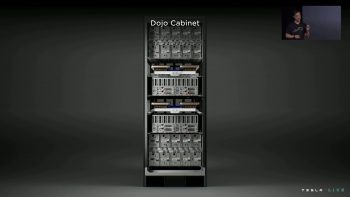By Ryan Daws
October 3, 2022
https://twitter.com/gadget_ry
Categories: Artificial Intelligence, Companies, Machine Learning, Robotics
The Purpose-Built AI Supercomputer “Dojo”
Tesla’s purpose-built AI supercomputer ‘Dojo’ is so powerful that it tripped the power grid. Dojo was unveiled at Tesla’s annual AI Day last year but the project was still in its infancy. At AI Day 2022, Tesla unveiled the progress it has made with Dojo over the course of the year.
Tesla’s AI Supercomputer: A Game-Changer
Dojo is not just a regular computer; it’s a powerhouse designed specifically for Tesla’s AI needs. The supercomputer has transitioned from just a chip and training tiles into a full cabinet. Tesla claims that it can replace six GPU boxes with a single Dojo tile, which it says is cheaper than one GPU box.
Dojo’s Architecture
Per tray, there are six Dojo tiles. Tesla claims that each tray is equivalent to ‘three to four full-loaded supercomputer racks’. Two trays can fit in a single Dojo cabinet with a host assembly. This modular design makes it easier to scale and integrate into Tesla’s existing infrastructure.
The Power Draw: A Cautionary Tale
Dojo requires so much power that it managed to trip the grid in Palo Alto. Earlier this year, we started load testing our power and cooling infrastructure. We were able to push it over 2 MW before we tripped our substation and got a call from the city.
Building Custom Infrastructure for Dojo
To function, Tesla had to build custom infrastructure for Dojo with its own high-powered cooling and power system. This meant creating a dedicated power grid just for the supercomputer.
The ExaPOD: A Full-Stack Solution
An ‘ExaPOD’ (consisting of a few Dojo cabinets) has the following specs:
- 1.1 EFLOP
- 1.3TB SRAM
- 13TB DRAM
Seven ExaPODs are currently planned to be housed in Palo Alto.
Dojo’s Impact on Tesla’s AI Capabilities
Dojo is purpose-built for AI and will greatly improve Tesla’s ability to train neural nets using video data from its vehicles. These neural nets will be critical for Tesla’s self-driving efforts and its humanoid robot ‘Optimus’, which also made an appearance during this year’s event.
The Humanoid Robot: Optimus
Optimus was also first unveiled last year and was even more in its infancy than Dojo. In fact, all it was at the time was a person in a spandex suit and a logo.
Development Timeline for Optimus
The development of Optimus has been nothing short of remarkable. It’s been years in the making, with significant milestones achieved each year. The robot has evolved from its basic form into a fully functional, humanoid machine capable of performing complex tasks.
Future Expectations for Optimus
Tesla has shared some exciting updates about its plans for Optimus. The robot is expected to reach full human-level intelligence within the next few years. This will be a major milestone in Tesla’s quest to create autonomous vehicles that rival or surpass those of traditional automakers.
Stay Informed About AI Day and Related Opportunities
If you’re interested in staying updated on the latest developments in AI, data, and machine learning, make sure to check out our upcoming event: AI Day. The event will feature talks from leading experts in the field and provide a platform for discussing the future of AI.
This concludes the article. For more insights into Tesla’s cutting-edge technology and its impact on the automotive industry, keep an eye on our channel for the latest updates.
